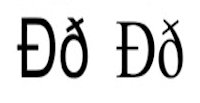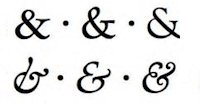12 Letters that Did Not make the American English Alphabet -Page 3

Eth
Eth is kind of like the little brother to thorn. Originating from Irish, it was
meant to represent a slightly different pronunciation of the "th" sound, more
like that in "thought" or "thing" as opposed to the one found in "this" or
"them." (The first is the voiceless dental fricative, the second is the voiced
dental fricative).
Note that, depending on your regional accent, there may not be much of a
difference (or any at all) in the two pronunciations anyway, but that's Modern
English. Back in the old days, the difference was much more distinct. As such,
you'd often see texts with both eth and thorn depending on the required
pronunciation. Before too long, however, people just began using thorn for both
(and later "th") and so eth slowly became unnecessary.

Ampersand
Today we just use it for stylistic purposes (and when we've run out of space in
a text message or tweet), but the ampersand has had a long and storied history
in English, and was actually frequently included as a 27th letter of the
alphabet as recently as the 19th century.
In fact, it's because of its placement in the alphabet that it gets its name.
Originally, the character was simply called "and" or sometimes "et" (from the
Latin word for and, which the ampersand is usually stylistically meant to
resemble). However, when teaching children the alphabet, the & was often placed
at the end, after Z, and recited as "and per se and," meaning "and in and of
itself" or "and standing on its own."